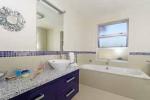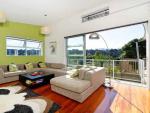Sustainable Solution
Pooling equity to create an extended family home seemed a logical step to Neil Jacka and Jacqui Simpson. The couple had planned to build a home behind Neil’s parents’ house in the Auckland suburb of Avondale once the property was subdivided.
Because they wanted a well-designed, sustainable home, they called in Johann Bernhardt, of Bernhardt Architecture, who had designed a home for one of Neil’s colleagues.
But when the costs of subdivision and building started escalating, the project was canned and the two families began looking for a section where they could start anew. Eventually they found a suitable site with a northerly aspect in the Oratia foothills, in west Auckland. “So we went back to Johann and said we’re going to have another go at this,” says Neil. While the couple was determined to incorporate as many sustainable features as possible, they also had an eye on practicality and budget. They also wanted the home to be single level so Neil’s parents could get around easily and they wanted separate north-facing living areas for each family. Incorporating passive solar gain was also important, as was open plan living that flowed outdoors but could be closed down if required.
Although the two living areas are connected by what Johann calls “a hinge” – a common area comprising an entrance and sunroom, Neil’s parents part of the house is classified as a minor dwelling because it has its own kitchen, as well as the living area, bedroom and bathroom – limiting its size to 65sq m.
The main part of the house has two bedrooms for their children, a storeroom, a bathroom and the open plan living, dining and kitchen area. Downstairs from the lounge, is Neil and Jacqui’s bedroom with its own en suite.
The main living area and sunroom open out to a terrace, which is joined to a deck that wraps around the northwestern corner of the house. An internal access garage sits on the south side of the home. Johann says of the design, “I stretched the living areas east-west for maximum exposure to the sun and used the entrance and sunroom between them as a common area. This layout allowed me to create a semi-outdoor open space protected from the east west and south so that if the wind isn’t coming from the north – and it hardly ever does in winter – then you can keep the doors open and enjoy the sun. “I positioned the garage to the south as a buffer to the weather and used minimal windows in the rear of the house.”
It’s a design that works perfectly for the extended family. “Johann nailed the layout first time,” says Neil. “He offset the minor dwelling and major dwelling so that both living areas get flooded with light.”
And that sunlight helps to warm the comprises air-pockets below for insulation. This minimises the use of polystyrene which is only used around the edges of the slab. This system of insulation means any heat released goes into the home. To maintain warmth in the home on cold, overcast days, the slab has a hydronic heating system powered by a 20kW wood pellet burner. The burner also provides back-up heating for the solar hot water systems that serve each of the
dwellings.
The distinctive brown tinge of the ground and polished concrete floor is due to the aggregate that Neil sourced from Te Kuiti. He didn’t like the various shades of grey of most concrete floors so experimented with different aggregates until he got the colour he wanted.
Because the floor slab has some tricky elements such as limestone in the mix and airspaces beneath it to cut down on the amount of polystyrene, Neil, a project engineer, decided he would oversee its construction before handing it over to the builder, Location Homes, to finish the job.
“I took a couple of months off work and said ‘I’m going to deliver you a slab’. With the help of Firth Concrete on what was a complex, one-off pour, Neil was true to his word.
Timber flooring – eucalyptus saligna - has been used in the lounge and in combination with the concrete, cuts down on dust and makes for easy cleaning. Skirting boards are cut at an angle and cupboards taken right up to the ceiling to cut dust accumulation. Carpet has been used in the bedrooms for comfort, while the home has low-toxicity paint throughout.
The home has a conventional lightweight timber frame although the walls are 150mm thick as opposed to the standard 100mm. “I reckon one of the best returns on investment is going for 150mm thick walls because it doesn’t cost that much more but it has allowed us to have very high levels of insulation and this place holds the heat amazingly,” says Neil.
The ceiling spaces of the monopitched rooflines have two layers of insulation layed at 90 degrees to each other. There are no recessed downlights in the home because they require holes to be cut in the ceiling insulation, causing heat loss. Compact fluorescent lighting is used throughout the home to conserve energy.
Aluminium framed double-glazed doors and windows also help to keep the heat in while ventilation is provided by clerestory windows set high in the walls behind a cedar slat shading device that protrudes from the house.
“With the shading device I tried to create something that combines the need for shading with some aesthetic appeal,” says Johann. ColorSteel roofing was a natural choice because the family wanted to collect its own drinking water, which goes through coarse and fine filters before being passed through a UV tube for purification.
Wastewater is treated with a lowenergy Biolytix system that uses natural processes to treat solids and filter liquid before it is discharged into the garden. Organisms turn the solids into humus which acts as a filter for the liquids along with other media in the system.
Neil says one of the things he loves about the design is the lack of corner posts in the sunroom and his parent’s lounge so that when the doors are retracted the house is opened right out to the terrace.
“When we want it to, this whole space opens up so we can have both kitchens going and 30 to 40 people sitting down to dinner.” Neil says the great thing about the home’s design is that the family is able to easily regulate heat in the house, whether it be in the depths of winter or the height of summer.
“The clerestory windows are great for cooling the house in summer and we put a shade sail over the terrace, which also helps,” he says.
“In winter at about 3 or 4 in the afternoon we close the clerestory windows and the house stays toasty until about 10 at night.”
The director of Bernhardt Architecture, Johann Bernhardt is passionate about creating healthy, warm homes that are energy efficient and environmentally friendly. His firm has been designing these sorts of homes for many years, and he has also been running the Auckland office of the Building Biology and Ecology Institute, which researches, compiles and disseminates information on healthy and environmentally friendly building and living. Johann has an architect’s degree from Technical University Berlin, a PhD in urban development from Paris University VIII, and a lifelong interest in sustainability.




